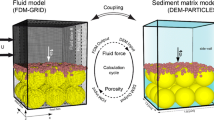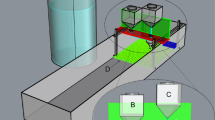Abstract
The hydrodynamical, fluid and particle parameters which control flushing rates, flow cells, and accumulation rates of particulate matter in cylindrical (MultiPIT) sediment traps were quantified in a flume simulation using a seeding technique for 25–45 µm particles. Particle collection was found to be a trap- and particle-specific filtering process encompassing advective and gravitational entry of particles over a reduced trap aperture area, and gravitational-turbulent removal of particles at the bottom of the internal flow cell. Trapping efficiency increased up to 10-fold with increasing horizontal flow velocity (1–30 cm · s−1). For given flow velocity, the trap over-and undercollected particles relative to their weight, i.e. (theoretical) Stokes settling velocity. The trapping efficiency increased with increasing trap Reynolds number ReT, changed by the approaching velocity in our experiments. Opposite findings from earlier experiments using the flume seeding technique and changing ReT by altering the trap diameter (Butman, 1986) are discussed. Semi-empirical equations are derived for the accumulation process of light, heavy and intermediate particles. From these, measured trap fluxes can be converted into in-situ verticle particle flux except for light particles.
Similar content being viewed by others
References
Baker, E.T., H.B. Milburn, and D.A. Tennant, 1988. Field assessment of sediment trap efficiency under varying flow conditions. J. Mar. Res. 46:573–592.
Bloesch, J. and N.M. Burns, 1980. A critical review of sedimentation trap technique. Schweiz. Z. Hydrol. 42:15–55.
Blomqvist, S. and L. Hakanson, 1981. A review on sediment traps in aquatic environments. Arch. Hydrobiol. 91:131–132.
Blomqvist, S. and C. Kofoed, 1981. Sediment trapping — a subaquaticin-situ experiment. Limnol. Oceanogr. 26:585–590.
Buesseler, K.O., 1991. Do upper-ocean sediment traps provide an accrate record of particle flux? Nature 353:420–423.
Buesseler, K.O., M.P. Bacon, J.K. Cochran, and H.D. Livingston, 1992. Carbon and nitrogen export during the JGOFS North Atlantic bloom experiment estimated from234TH:238U disequilibria. Deep-Sea Res. 39:1115–1137.
Butman, C.A., 1986. Sediment trap biases in turbulent flows: results from a laboratory flume study. J. Mar. Res. 44:645–693.
Butman, C.A., W.D. Grant, and K.D. Stolzenbach, 1986. Predictions of sediment trap biases in turbulent flows: a theoretical analysis based on observations from the literature. J. Mar. Res. 44:601–644.
Coale, K.H., and K.W. Bruland, 1985.234TH:238U disequilibria within the California Current. Limnol. Oceanogr. 30:22–33.
Coale, K.H., and K.W. Bruland, 1987. Oceanic stratified euphotic zone as elucidated by234TH:238U disequilibria. Limnol. Oceanogr. 32:189–200.
Gardner, W.D., 1980a. Sediment trap dynamics and calibration: a laboratory evaluation. J. Mar. Res. 38:17–39.
Gardner, W.D., 1980b. Field assessment of sediment traps. J. Mar. Res. 38:41–52.
Gardner, W.D., and Y. Zhang., 1996. The effect of brine on the collection efficiency of cylindrical particle traps. Deep-Sea Res.: in press.
Gust, G., 1982. Tools for oceanic small-scale, high-frequency flows: metal-clad hot wires. J. Geophys. Res. 87:447–455.
Gust, G., 1991. A fluid velocity measurement instrument. U.S. Patent #4986122.
Gust, G., R.H. Byrne, R.E. Bernstein, P.R. Betzer, and W. Bowles, 1992. Particle fluxes and moving fluids: experience from synchronous trap collections in the Sargasso Sea. Deep-Sea Res. 39:1071–1083.
Gust, G., A.F. Michaels, R. Johnson, W.G. Deuser, and W. Bowles, 1994. Mooring line motions and sediment trap hydromechanics: in-situ intercomparison of three common deployment designs. Deep-Sea Res. 41:831–857.
Hawley, N., 1988. Flow in cylindrical sediment traps. J. Great Lakes Res. 14:76–88.
Jobson, H.E., and W.W. Sayre, 1970. Vertical transfer in open channel flow. J. Hydr. Div., Am. Soc. Civ. Engrs. 96:703–723.
Johnson, R., G. Gust, W. Bowles, A. Michaels, and A. Knap, 1991. Flows around surface-tethered sediment traps (Multitraps) at the U.S. JGOFS Bermuda Atlantic Timeseries Station. The Oceanography Society Second Scientific Meeting March 24–28, 1991, St. Petersburg, Florida, U.S.A., Abstract volume, Abstract T2.BT.05, p. 43.
Knauer, G.A., J.H. Martin, and K.W. Bruland, 1979. Fluxes of particulate carbon, nitrogen, and phosphorus in the upper water column of the northeast Pacific. Deep-Sea Res. 28:97–108.
Knauer, G.A., D.M. Karl, J.H. Martin, and C.N. Hunter, 1984. In-situ effects of selected preservatives on total carbon, nitrogen and metals collected in sediment traps. J. Mar. Res. 42:445–462.
Knauer, G.A., and W. Asper, 1989. Sediment trap technology and sampling. U.S. JGOFS Planning Report No. 10, 94 pp.
Kwak, D., S.E. Rogers, U.K. Kaul, and J.C.L. Chang, 1986. A numerical study of incompressible juncture flows. NASA Tech. Memo 88319.
Lau, Y.L., 1979. Laboratory study of cylindrical sedimentation traps. J. Fish. Res. Board Can. 36:1288–1291.
Michaels, A.F., M.W. Silver, M.M. Gowing, and G.A. Knauer, 1990. Cryptic zooplankton “swimmers” in upper ocean sediment traps. Deep-Sea Res. 37:1285–1296.
Michaels, A.F., N.R. Bates, K.O. Buesseler, C.A. Carlson, and A.H. Knap, 1994. Carbon. cycle imbalances in the Sargasso Sea. Nature 372:537–540.
Peck, R.M., 1972. Efficiency tests on the Tauber trap used as a pollen sampler in turbulent water flow. New Phytol. 71:187–198.
Siegel, D.A., T.C. Granata, A.F. Michaels, and T.D. Dickey, 1990. Mesoscale eddy diffusion, particle sinking, and interpretation of sediment trap data. J. Geophys. Res. 95:5305–5311.
Staresinic, N., K. von Broeckel, N. Smodlaka, and C.H. Clifford, 1982. A comparison of moored and free-drifting sediment traps of two different designs. J. Mar. Res. 40:273–292.
Sundquist, E.T., 1985. Geological perspectives on carbon dioxide and the carbon cycle. In: The carbon cycle and atmospheric CO2: Natural variations archean to present, edited by E.T. Sundquist and W. Broecker, A.G.U., Washington D.C., pp. 5–59.
Author information
Authors and Affiliations
Rights and permissions
About this article
Cite this article
Gust, G., Bowles, W., Giordano, S. et al. Particle accumulation in a cylindrical sediment trap under laminar and turbulent steady flow: An experimental approach. Aquatic Science 58, 297–326 (1996). https://doi.org/10.1007/BF00877473
Received:
Accepted:
Issue Date:
DOI: https://doi.org/10.1007/BF00877473




